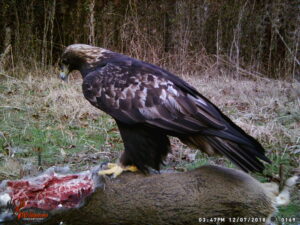By Bernheim

Forests are a big part of Bernheim’s identity. The large forest blocks that comprise Bernheim and exist throughout the knobs form a ring around the Bluegrass. The reason these forests still exist is mainly due to the steep terrain and topography found in the knobs, as anything with agricultural value has long ago been converted to pasture, crops, or developed for human habitats. It is these large forested blocks that are necessary for many species survival and are the reason for our rich biodiversity here at Bernheim.
The tracking of Harper, the golden eagle, has shed light on the importance of large forest blocks as critical winter habitat for golden eagles, leading to three main factors that seem to be required for establishing a territory. Researchers throughout the eastern United States have shown that golden eagles in the Appalachians and Mississippi Valley utilize large forest blocks as the main habitat. Steep and rugged terrain is another important factor in attracting golden eagles. Humans and their developed landscapes are avoided by golden eagles during winter range. To better understand the availability of habitat for golden eagles in Kentucky during the winter we have created a golden eagle model using GIS (geographic information system) to find which areas within Kentucky are suitable for these apex predators. The results are eye opening and demonstrate just how little habitat for golden eagles is found throughout central and western Kentucky.
The models (see images above; click on individual images to enlarge) show that winter habitat for golden eagles is largely concentrated on rugged terrain away from developed areas. A few things that stand out to me:
- Central Kentucky has very little habitat, especially in the Bluegrass region. The best remaining habitat in central Kentucky is in the knobs that form a chain from Louisville to the Daniel Boone National Forest and the Appalachian Plateau.
- Key areas in the knobs region exist in and around Bernheim Forest and Fort Knox. Other good areas are found in Casey and Marion County. This corridor of rugged and forested terrain is also used by black bear and other migratory species to move between Appalachia and the Midwest.
- Mammoth Cave, the Ohio River around Yellowbank Wildlife Management Area, and the area around the Cumberland River below the lake all have has considerable habitat remaining.
- Western Kentucky is largely poorer quality habitat, but areas do exist around Land Between the Lakes, Tradewater River, and the Green River.
- Eastern Kentucky still has a good amount of golden eagle habitat. Large areas exist throughout the Daniel Boone National Forest. Pine Mountain and Cumberland Mountains are all good habitats and have regular sightings of golden eagles migrating through the Appalachian corridor.
This model matches nicely to sightings of golden eagles throughout Kentucky. It also matches up well with the GPS tracks from Harper and the habitats he utilizes during the winter months. The results found here are useful for highlighting the importance of protecting large forest blocks if we want to keep this unique apex predator around central Kentucky. The midwestern golden eagle population and Harper are in danger from the continued loss of large forest blocks and fragmentation of their winter ranges. This golden eagle research project is one of many now demonstrating why we need to act to protect large forest blocks before they are gone.
It is a lot like humpty dumpty. Once he fell off the wall and was broken into pieces, no matter how much they tried it was not possible to put him back together again. I see the same situation with large forest blocks. Once fragmented by roads and development, no matter how hard we try there is no way to ever put these large forested blocks back together again. Let’s act while we can.
Stay tuned for our next installment highlighting at least 150,000 years of history between humans and golden eagles!

